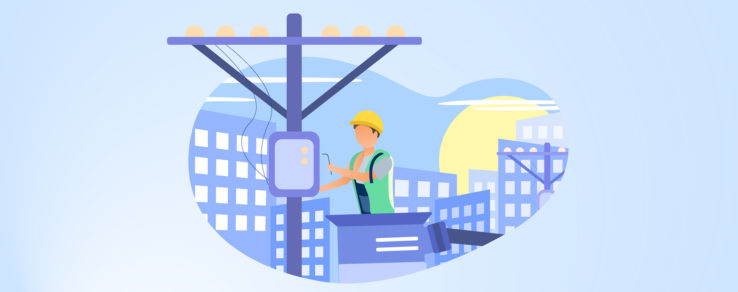The sky darkens. Thunder rumbles in the distance. There’s a boom! The power goes out. An energy utility customer has an important project due later in the day. Will the power be back on before then? Does her energy provider even know it’s out?
Power outages are a frustrating experience for customers, negatively impacting their daily lives. Both residential and business customers depend on outage communications from their energy utility to mitigate the impact of an outage and plan their day accordingly.
Depending on how your energy utility handles the situation, the right outage communications can actually improve customer satisfaction. Discover what actions to take before, during and after an outage to ensure your customers are prepared when the lights go out.
What are outage communications?
Energy utility customers don’t want to be left in the dark during a power outage. For energy utilities, outage communications are a vital way to keep customers informed when a storm is approaching or when an outage occurs. Outage communications, whether emails, text alerts or social posts, provide important details like the number of customers impacted, locations affected by the outage and estimated restoration times.
Every energy utility has a different strategy for handling outage communications, but those with higher levels of customer satisfaction have a few things in common. In particular, they focus on continuous and transparent communications with their customers.
How do outage communications impact utility customer satisfaction?
For energy utilities, the right outage communications strategy is essential for long-term customer satisfaction. Questline Digital’s metrics find that 82% of customers prefer proactive communications during an outage. Additionally, customers are more responsive to outage communications than other types of energy utility messages.
According to Questline Digital’s Energy Utility Benchmarks Report, the open rate of outage communication emails is 31.4%, the highest engagement next to Welcome Series and billing notifications. Not surprisingly, energy utilities using outage communications are experiencing higher customer satisfaction numbers. For example, Questline Digital clients using outage alerts received some of the highest approval ratings in their respective segments.
J.D. Power has measured a direct connection between outage communications and customer satisfaction. According to the J.D. Power 2018 Electric Utility Residential Customer Satisfaction Study, overall satisfaction among customers who receive outage communications is much higher than among those who do not receive such information.
“Proactive communications, primarily delivered through digital channels, such as email, text message or social media post, are having a significant positive impact on residential electric utility customer satisfaction,” said John Hazen, senior director of the energy practice at J.D. Power. “Power outages are going to happen. The more proactive electric utilities are in clearly communicating information about the cause, anticipated duration and repair of an outage, the more satisfied their customers will be with their overall service.”
According to Chartwell’s 2020 Residential Consumer Survey, 60% of customers were satisfied with their energy utility’s communications during outages. However, this was dependent on how well the utility communicated estimated restoration times and what type of communication channels were used.
What messages to send before, during and after a storm
Energy utilities need to consider what outage communications will be sent out before, during and after an outage, and how best to reach customers to achieve higher levels of customer satisfaction. The right outage communications strategy makes all the difference, whether your energy utility is sharing storm and outage safety tips ahead of storm season or sending power outage notification emails to keep customers informed.
Best practices for outage preparation emails
The prep work starts long before a storm is imminent. Energy utilities should send outage communications at the start of summer and winter storm seasons, informing customers of key services like outage text alerts and outage maps, as well as essential safety tips. If your energy utility has an online outage center, it’s important to make it current and have a backup plan is in place in case the technology fails.
For example, a Southeast energy utility developed a creative campaign to promote text alerts that emboldened customers with the strong message of “Take Your Power Back.” The powerful campaign inspired customers to sign up to receive power restoration alerts and other outage-related texts so they could prepare before a storm or potential outage.
The campaign targeted customers who were not already signed up for text alerts with messaging focused on the benefits of real-time notifications. A clear call-to-action drove customers to My Account to sign up. By receiving these instant outage communications, the campaign emphasized how customers would no longer feel powerless during an outage.
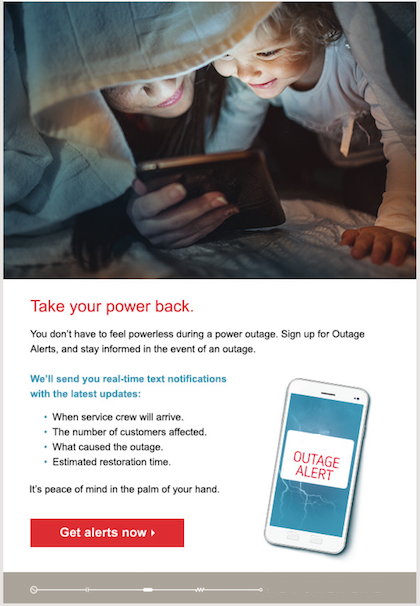
To prepare customers ahead of time, Duke Energy promotes its mobile app on social media as an easy way to report outages and check for restoration updates. Outage communications like this social media campaign help customers to better prepare for future outages, ensuring greater customer satisfaction.
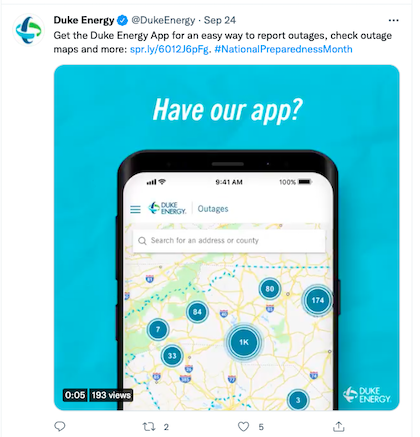
Best practices for power outage notification emails
During a storm, emails, text alerts and social posts communicate that energy utilities are ready and have a solid restoration plan in place. These messages should also inform customers about the size of the outage, which areas are affected, what caused the outage and when power is estimated to be restored.
When a winter storm hit the Northeast, PSEG Long Island sent out a power outage notification email informing customers that the storm was causing hazardous weather conditions. The email also alerted customers that the energy utility’s crews were working to restore power to all customers affected as quickly as possible.
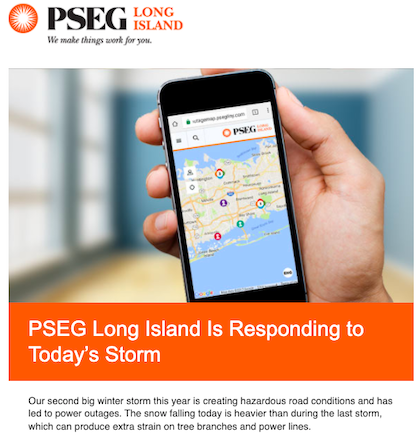
To make it easy for customers to report an outage or receive updates, the outage communication also provided links to PSEG Long Island’s Storm Center, outage map and social media channels. It also included helpful storm safety tips.
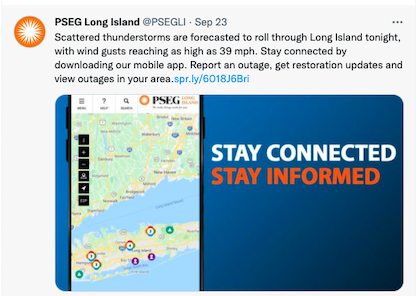
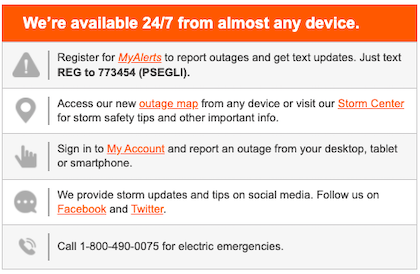
Consumers Energy sent a power outage notification email to share important details with its Michigan customers about the restoration process underway, while also being transparent that more severe weather is expected. The email provided safety tips and links where customers could check the status of an outage and sign up for restoration text alerts.
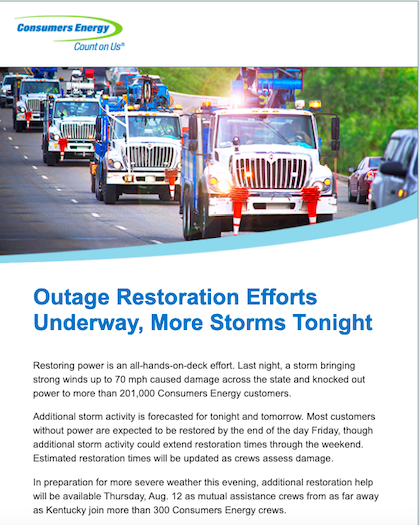
Best practices for utility power restored alerts
Once a storm has passed and power has been restored, utility power restored alerts are the final step in your outage communications. These communications notify customers that power has been restored and thank them for their patience.
Following the damage caused by Hurricane Ida, Entergy shared regular updates regarding the power restoration process on Twitter. One post linked to the utility’s newsroom, which highlighted that the Category 4 hurricane commanded the largest restoration workforce in the company’s history. While showcasing the impressive work of the Entergy team, the utility’s power restored alert tempered expectations for customers who may still be without power.
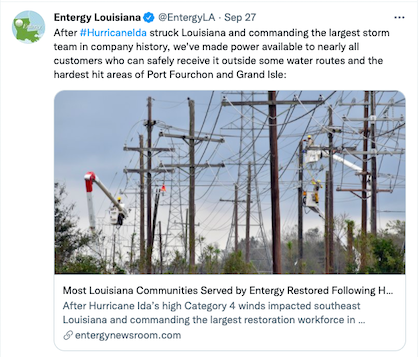
When an outage happens, it can make or break the energy utility customer experience. But the way your energy utility responds to the situation makes all the difference. For long-term customer satisfaction, your energy utility needs an outage communications strategy that is ongoing, transparent and connects with customers on multiple channels.

